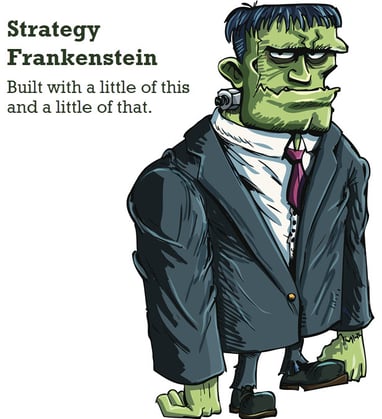
Strategy is not a top priority for startups, entrepreneurs, and freelancers. The leaders are hunters in unfamiliar territory. To consider a strategy in the early stages seems a bit like making a plan to survive on Jupiter. Relying on theory, science and data works until it becomes apparent that it doesn’t.
What is it?
Think of a strategy is a directed plan to which you commit your time and action in a single direction. A strategy aligns how you spend your time, money, resources, and your communication. This increases your chance for success.
The difficult questions with no answer
In my early years, people would ask ‘who is your target,’ ‘how do you differentiate your business,’ ‘what is your strategy,’ along with other deep thought questions. The answers were neither simple or obvious. This did not keep me from doubling sales (repeatedly). I look back now and realize there were easier, more efficient and less costly options.
You already have a strategy
I will make the case that ‘because you don’t know your strategy does not mean you don’t have a strategy.’ Not having the ability to speak about a strategy and present it in an organized fashion to teach someone else is not a lack of strategy.
i.e., There are many genius professionals who have the skills to build, repair, fix, network, sing, and dance who are not able to express how or why they are remarkable or their methodology for delivering excellence.
Because startups and new businesses have limited resources, very small teams, and similar skills, there is an organic strategy they agree on without giving it a name or before it is identified.
Simple examples
Most startup entrepreneurs rely on simple strategies which fit their teams’ skills and talents.
- “We are going to grow our business by networking until our shoes are worn, we have hand calluses from handshaking, and meet (and impress) as many prospects as possible.”
- Another you might recognize: “Training - Provide workshops to educate, inspire and motivate people.”
“Ultimate Networking” and “Training, Training, Training” are strategies. They are simple, straightforward, and within each of these strategies, tactics are added (with a guerrilla marketing mindset). These particular strategies have some overlapping activities.
Check out “Boots on the ground” strategy. “Boots on the Ground Strategy” is about walking and connecting. Businesses, homes, churches, schools… get the boots walking, and connect personally. “Knock, knock, knock… hello, my name is!” becomes a mantra.
One of my favorite strategies for the last 20+ years is the ‘Warm Call Strategy.’ All it takes is a telephone and the Internet for quick research. Sample activities and tactics might be about when to call, who will make the call, the attention-getting ‘script,’ and what to offer.
A common strategy for professionals (attorneys, accountants, financial advisers, consultants) is 'Authority Awesomeness'. Building an awesome authority may include activities and tactics which are also used for other strategies. This can easily confuse a less experienced group of managers. I.e., webinars can be used for both “Training, Training Training” and “Authority Awesomeness” strategies.
Inbound marketing is a strategy. Content-based, education, earn attention vs. interrupt. It relies on human nature as someone is always searching for answers to get more or solve a problem.
Hopefully, you won’t need the “Dramatic Discount Strategy” which includes deep discounts everywhere. There are businesses which rely heavily on the consistent “Dramatic Discount Strategy” (JoAnn’s?), Or you could be in the hype business, “Buy before the price doubles in 2 days.” The “Hype Strategy” requires a string of hype and can soon wear down a brand. “Fire Sale” when there is no fire is hype.
The trick - One strategy I prefer to avoid is ‘be generous only to get more.’ People can sense the intent pretty quickly. Generosity is a belief, a habit, a way of life, not a marketing strategy or tactic. Using “Pay it Forward” principles to trick people into feeling more comfortable to manipulate them to buy a product or service will backfire as people soon learn your intent.
At this point, it is not too difficult to recognize the unnamed and undefined strategies of those who are passionate and skilled in their trade. When you look at your business (or your competition), it soon becomes apparent why it is difficult to measure success, and the managers (and owner) are working too many hours. It is because of the Strategy Frankenstein.
The Strategy Frankenstein

As a business evolves, revenues grow, the staff is larger, and the managers and owner’s activities begin to overlap (or conflict).
This evolution can cause a Strategy Frankenstein because new strategies were added ‘on-the-run’ as they made sense at the time.
The reason a new larger business (which is no longer a start-up) is unable to answer ‘what is your strategy’ or ‘who is your target’ has more to with subtle add-ons.
At a meeting, someone has a brilliant idea, and the team runs with it. The idea works for a particular situation but stretches the resources and inadvertently has added another pseudo-strategy. By the end of the month, the activities are ‘everywhere,’ and it becomes difficult to measure results/success because there is not a consistent process or strategic focus.
Multiple strategies
Having multiple strategies splits the resources and the team focus. The Strategy Frankenstein feels powerful and keeps everyone busy… often too busy to measure results.
Very early on, the hunters in the business followed their gut and took action based on opportunity. Soon the hunter is carrying traps, fishing poles, guns, bow, shovels and more. “I can hunt anything.”
Stone
Nothing is in stone. Especially for those business owners who live on a rocket ship and have an accelerated evolution. They speed learn, test many possibilities and may make decisions based on their savvy. This is risky when their staff grows because the team is unable to zig-zag and adapt as quickly as is needed.
Call in the pros
A professional will help the young company identify the strategies already in play… and may even give them a name just as I did earlier. A strategy keeps the team working together in sync. Each activity and tactic are much like the right instruments in an orchestra. The goal of the pro is not necessarily to “pick a strategy” that is difficult for the team to learn and force a team to learn new habits. The goal is to leverage resources, the team and keep everyone aligned. (This will help to avoid a future Strategy Frankenstein.)
For a business which has been successful primarily because of the talent (vs. a process and system), and each talent on the team has their own strategy and processes in place, there comes a time when inefficiencies, conflict and confusion limits future opportunities.
In this case, the pro will use their ability to see the jumble of skills, resources, activities, and processes and lay out a plan that helps the managers, business owners, and staff get in sync. I have seen this double productivity, lower stress, and improve results.
The future
A new strategy may or may not be required. A company with a strategy, the tools, and a skilled team may need someone to help prioritize, plan, and provide an analysis.
If you have never managed or owned a business with $10 million in annual revenue and hope to grow from $1 million in revenue, you can expect a Strategy Frankenstein to appear.
Before you ‘develop a strategy,’ maybe it makes more sense to inventory and identify your current strategy. If your business has revenue growth your core strategy has value, even if it goes unnamed. There may be other opportunities you have not yet realized.
More strategy examples
If you are interested in more strategy examples, here is an article for you:
“21 Revenue Strategy Examples to Kickstart Your Revenue Growth”
